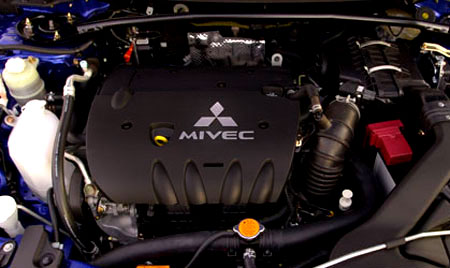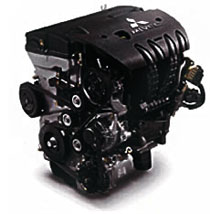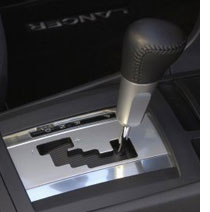
Since the new 2007 Mitsubishi Lancer is coming soon, I decided to dig up some details on the new GEMA engine under the hood. The previous Lancer that is on sale on our market now uses the all-familiar 1.6 litre 4G18 engine, similar to the one that we used to find under the hood of our Proton Waja, with one of the few minor difference is that the Waja uses a 4-speed auto while the Lancer uses a CVT.
The new 2007 Lancer has it’s engine upped to 2.0 litre, putting it head to head with the Civic 2.0. The new GEMA engine is a joint venture project between DaimlerChrysler, Hyundai and Mitsubishi. Hyundai has yet to use the GEMA engine in any of it’s cars, while DaimlerChrysler’s now-sold-off Chrysler used it as it’s flagship 2.0-2.4 litre.
The GEMA engine is called the 4B1x series in Mitsubishi terms, and the 2.0 litre model that we will see in the 2008 Lancer is the 4B11, with the Lancer Evolution getting the 4B11T. It is probably the first time a non-Sirius engine has been used in a Lancer Evolution. All Evolutions, from the Evo I to the Evo IX used some variant of the Sirius 4G63T, with the latest in the Evo IX getting MIVEC variable valve timing.
 The 4B11 is a 4-cylinder DOHC engine with MIVEC variable valve timing on both intake and exhaust valves, making it somewhat equivalent to Toyota’s Dual VVT-i. In it’s US market application, it makes 152 horsepower at 6,000rpm (143 horsepower in California because of higher emission regulations) and 198Nm of torque at 4,250rpm, with 176Nm available from 2,500rpm. The 4B11 uses a new aluminium cylinder block as well as an aluminium cylinder head. A timing chain is used instead of a timing belt.
The 4B11 is a 4-cylinder DOHC engine with MIVEC variable valve timing on both intake and exhaust valves, making it somewhat equivalent to Toyota’s Dual VVT-i. In it’s US market application, it makes 152 horsepower at 6,000rpm (143 horsepower in California because of higher emission regulations) and 198Nm of torque at 4,250rpm, with 176Nm available from 2,500rpm. The 4B11 uses a new aluminium cylinder block as well as an aluminium cylinder head. A timing chain is used instead of a timing belt.
While most engines are usually either bore-biased (rev-happy) or stroke-biased (better torque), the new 4B11 is a “square” engine – it has a bore and stroke that both measure 86mm, giving a good balance of rev-happiness and good torque. It uses as compression ratio of 10.0:1, but can still use RON92 (87 AKI) fuel.
The MIVEC system uses valve overlap to reduce pumping losses under normal conditions, but under high engine speed conditions where maximum power is needed, intake valve closing time is retarded to allow for larger air volume. In a similar high load condition but at low engine speeds, intake valve closing is advanced instead, ensuring sufficient air volume, but exhaust valve opening is retarded to provide a higher expansion ratio and improved efficiency.
To ensure stable idling, valve overlap is eliminated during idle conditions. As previously mentioned, this version of MIVEC can adjust both intake and exhaust valves independently for maximum flexibility in valve control.
Mitsubishi has employed a 4-point inertial axis system with cylindrical hydraulic engine mounts on the left and right sides to help reduce engine vibration, ensuring smooth and quiet operation. On the right side mount where the engine is, a lightweight, high-rigidity squeeze-cast aluminium bracket helps reduce engine noise under acceleration. On the left side where the transmission is, a similar lightweight, high-rigidity plate bracket made of steel helps reduce gear noise. For the front and rear engine mounts, a custom-tuned insulator helps control both idle vibration and acceleration shock.
The engine can be mated to either a 5-speed manual gearbox or a CVT transmission with 6 virtual gears that are selectable using paddle shifts on the steering wheel. Mitsubishi picked 6 gears (in reality because they are unlimited to pick from, you could have 50 CVT virtual gears if you wanted) because it offered the best balance of ease of use, sporty driving, and flexible performance.
The 5-speed manual is an improvement over the old 5-speed transmission – the third and fourth gears now use double-cone synchronisers for smoother shifting and a new honing process was used to reduce noise. The gear ratios have also been adjusted to suit the torque curve of the new engine.
 The CVT transmission’s ratio range is from 2.349 to 0.394, with infinite variations in between, which gives wider ratios than the previous 4-speed auto that had a ratio spread of 2.842 to 0.712. A much higher achievable overdrive ensures good fuel economy and lower engine speed for highway cruising. The INVECS-III software in the CVT customises shift patterns on the fly to match the acceleration and brake patterns of the driver. If you select the L mode, the INVECS-III software shifts to allow for more engine braking if the car has to go down slopes.
The CVT transmission’s ratio range is from 2.349 to 0.394, with infinite variations in between, which gives wider ratios than the previous 4-speed auto that had a ratio spread of 2.842 to 0.712. A much higher achievable overdrive ensures good fuel economy and lower engine speed for highway cruising. The INVECS-III software in the CVT customises shift patterns on the fly to match the acceleration and brake patterns of the driver. If you select the L mode, the INVECS-III software shifts to allow for more engine braking if the car has to go down slopes.
Something alot of people miss when switching from conventional fixed ratio gearing to CVTs is the lurching feel when you floor the pedal from a stand still. The way a CVT-equipped car starts may be interpreted as sluggish by our minds – this is known as the rubber band effect. INVECS-III can simulate this lurching that the driver expects.
Anyway, this engine looks like a very modern engine with a gearbox combination that promises to be great for both city and highway driving. You’ve got ample amounts of torque from a low 2,500rpm for a comfortable city drive, plus a CVT to keep the revs at the sweet spot. You’ve got a good low maximum overdrive ratio of 0.394 for good highway fuel economy and a relaxed low engine speed cruise. Finally, for whenever you feel like driving spiritedly, there are the paddle shifters.
On paper, the Lancer’s drivetrain sounds good. An invite for the launch, Mitsubishi Malaysia? :)
UPDATE: Look at two videos after the jump explaining some technical details on the 4B11 as well as it’s matching INVECS-III CVT gearbox, thanks to reader Rikeys.
Related Posts:
2007 Mitsubishi Lancer spotted on the LDP!
2007 Mitsubishi Lancer in Malaysia – Q3 2007?
New 2007 Mitsubishi Lancer specs and photos revealed
Video: Mitsubishi 4B11 Engine
Video: Mitsubishi INVECS-III CVT Gearbox
Looking to sell your car? Sell it with Carro.













Hi Paul,
Don’t forget me when you get the invite from MM, can I tag along ;) I’m really in love with this babe, that’s why never in life I have learnt so much about Mitsubishi than the past 1 week. I have done some research to compare this babe with Civic 1.8 (being on the same price range, fingers crossed) and noticed this babe beat Civic 1.8 on most accounts. Can’t get hold of the fuel economy figures though. Do you have any figures on this?
Wow…
Totally great engine… more power with just RON92 fuel. Save a lot to your pocket..
Proton should go for this technolgy, since all Malaysian not good in their ‘deep pocket”.
mitsubishi says estimated 22 mpg city / 29 mpg highway for the cvt model.
22 mpg = 10.7 liter per 100 km
29 mpg = 8.1 liter per 100 km
Still good for a 2.0L model with such a great output.. i think in city driving is around RM0.20/KM, while in highway is around RM0.16/km. Reasonable for such a big, heavy and powerful car..
Latest results of Phase 1 (engine) match-up between 2007 Lancer vs Civic 1.8 (my personal view only):
Round 1- Top speed – Lancer
Round 2- Pick up – Lancer
Round 3- Fuel economy/ environmental friendliness- Civic
Phase 2 (ride and handling), Phase 3 (styling), Phase 3 (after sales services) will follow after this.
Paul, pls continue to blog about this Lancer, will you?
Sounds like a great engine on paper.
However, as must as the response you get from a N/A engine, forcefed engines make more sense here with high road tax based on engine capacities.
A lightly tuned modern forcefed 2.0L engine will easily push past 200hp and 200ft-lbs of torque and not compromize too much on fuel economy.
This is how the Lancer engine functions….
URL: http://www.youtube.com/watch?v=Bb4zdcD0G-Y
About the Lancer CVT gearbox
URL: http://www.youtube.com/watch?v=4kNtFu9kbEY&NR=1
wow i’m impress with Mitsubishi putting so much new innovation and technology into their car. i cant wait to see the real thing and test drive it..looking forward to it
after watching the 4B11 engine video i have a feel that maintainance on this engine is quite costy since they mention selected fit and this engine is not quite mod-able..
Hi Paul, should there be any delay of invitation from Mitsubishi M’sia, I’ll be more than happy to extend one to you.;)
Well, mivec can be mod-able.. Just the $$$.. If u are rich, anything also can mod.. I think if u want to put a few ponies in that machines easy, just change to high cam.. I bet this will improve at least 10-30hp depending on your setting.. Anywayz if u want to mod it, why not just wait for the Evo X?
A transmission ratio of 0.394????
This sounds like 800 RPM at 200 km/h; Wonder how this should help…
looks like a video suitable 4 the course i’m studying.
lolz !
not so sure what it means by ‘innovative’
since even this MIVEC has no secondary aggresive cam which batter lift and longer duration for its anger breathe,
-simply is vvt, pretty basic ,well.. exhaust vvt makes a different presumably,
timing chain, ? no problem ,Lambo ,merc bmw use timing chain,
longer service life, change it just when engine needed overhaul or rebuild,
oops gearbox ,if faulty- buang!!
looks like a complicated engine. Are the local Mitsu engineers got enough training already kah ?
anyone know if adding a low-pressure turbo kit, can the original 4B11 take the higher power ?
It is not complicated at all. If you look at Nissan B14 year 1996 engine, all the valve configuration, timing chain look about the same. Only major difference is that the Nissan B14 only have one CVT on the inlet valve side, none on the ex. valve.
Being a Mitsubishi owner myself for the past 18 years, I find this engine and gearbox combo a major improvement over previous engines and trannies. Now, I wish MM would invite me for a test drive. Who knows? I may just book one on the spot since I will retire my daily driven car, a Galant VR4 for weekends only… :)
Actually, even older Mitsubishi engines esp the 4Gx and 6Ax require quality engine oil to keep it healthy. Pls don’t use RM 30 engine oil on either of those engines. Yes, it will work but u will damage it.
Some complaint that tappets noise is normal on 4Gx and 6Ax but let me tell u something… it’s BS! Noise is a result of a clogged hydraulic tappets. Plus, u can’t just use engine flush (will will make it worse).
Only way is to use drain oil from engine, fill it with cheap mineral oil, let it run for 30 mins and flush the whole thing together n replace with original Mitsubishi oil filter (not Proton or China-made OEMs).
A typical service costs me RM 150 (with oil and filter) and if require flushing, add another RM 50. Till today, my 4G63T is quiet and smooth. Tmw is D-Day, a day to dyno the engine after upgrading a few parts.
This 4B11 engine is one of the best mits engine, mits has put a lot of new technology on this new lancer and also the new outlander to regain the market confidence especially the US consumers…
hi everybody…im new user here…
i wonder how much is this lancer?
Cool!!! Technical videos!
Just a right time MM to introdure this conpetitive price ( Rm118k on the road ) for lancer to completing with civic 2.0.Both car are almost same
specification but MM come with fully inport form JP and cheap edition.
YES! Finally one more interesting model on M’sia road.
I am about to get one myself just that there’s no test unit available yet. I wonder if there’s an auto throttle blip for downshifts? Anyone has test driven one yet ?
Furthermore, wikipedia stated that the fuel cut is at 8000rpm…here’s the extract :-
The engines’s bore and stroke both measure 86.0 mm, which engineers refer to as square. According to Mitsubishi, the new cylinder dimensions contribute to a free-revving character (6,500 rpm redline, 8000 rpm final), linear power delivery and wide torque curve. Mitsubishi used a timing chain instead of a belt for better reliability, iridium spark plugs to lower emissions and to help extend major service intervals for lower cost of ownership. To reduce weight, Mitsubishi used a plastic cam cover and intake manifold and double-layer stainless steel exhaust manifold. The exhaust manifold has a rear location on the transverse engine, compared to the front location for the previous engine, yielding important benefits such as better emissions performance. To lower vibration, Mitsubishi used a 4-point inertial axis system with cylindrical hydraulic engine mounts on the left and right sides. A lightweight, high-rigidity squeeze-cast aluminum bracket on the right side mount (engine side) lowers engine noise under acceleration. A lightweight, high-rigidity steel plate bracket on the left side mount (transmission side) lowers gear noise. A custom-tuned insulator was developed for the front and rear mounts to help control both idle vibration and acceleration shock.
Confirmation for the above is much appreciated.
Thanks.
i not like engines that need extra expense of having to adjust the valve clearence.
PASS
can i put invecs 3 cvt in my 2004 waja?